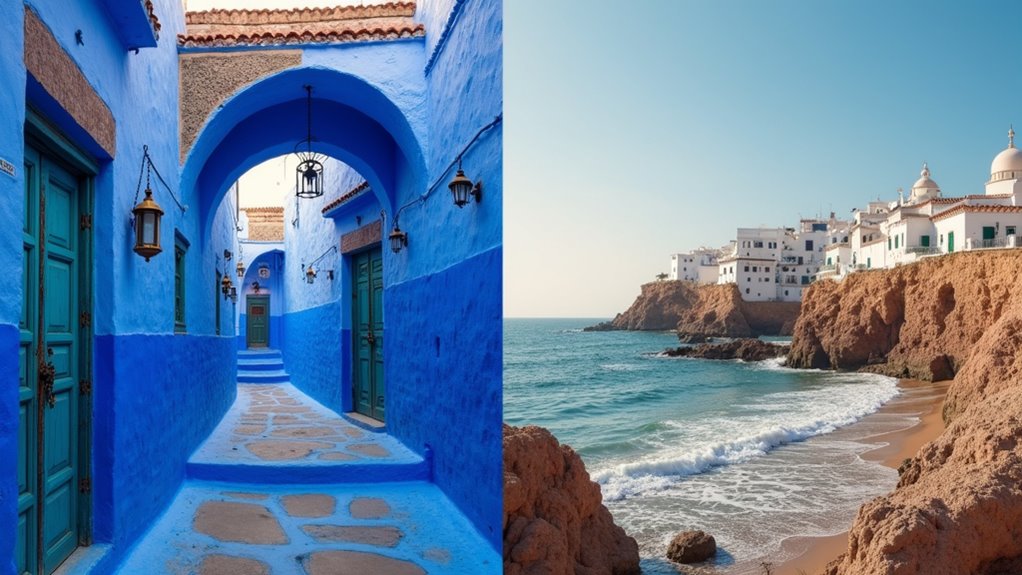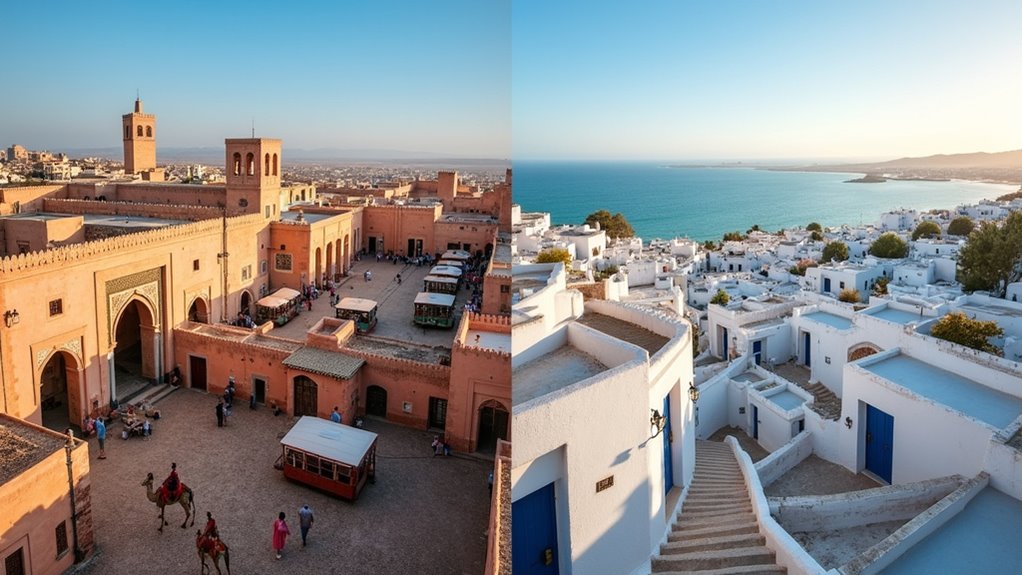Physical Address
304 North Cardinal St.
Dorchester Center, MA 02124
Physical Address
304 North Cardinal St.
Dorchester Center, MA 02124

Into the heart of North Africa: discover which country offers your ideal adventure between Morocco's vibrant souks or Tunisia's ancient ruins.
Morocco offers diverse landscapes (Atlas Mountains, Sahara Desert) with vibrant medinas and Berber culture, but at higher costs. Tunisia provides Roman ruins like El Jem Colosseum, Mediterranean beaches, and is about 30% cheaper overall. Choose Morocco for varied adventures and bustling markets, or Tunisia for relaxed coastal experiences and ancient history on a budget. Your perfect North African getaway depends on what you value most in a destination.

When deciding between Morocco and Tunisia for your next North African adventure, you’ll find two countries with distinct personalities despite their geographical proximity. Both offer stunning Mediterranean coastlines and Saharan landscapes, but differ markedly in key areas.
Neighboring yet distinct, Morocco and Tunisia offer contrasting North African experiences beneath the same Mediterranean sun.
Morocco presents more geographical diversity with its Atlas Mountains, ancient medinas, and vibrant markets. It’s generally more developed for tourism but comes with higher prices, especially in popular spots like Marrakech. In contrast, Tunisia delivers excellent value with lower accommodation and dining costs.
Tunisia is known for pristine beaches and impressive Roman relics, including the magnificent El Jem Colosseum, which stands as the third largest Roman amphitheatre in existence. The country’s smaller size makes it easier to navigate if you’re short on time. Choosing between Morocco and Egypt can be a tough decision, as both offer unique cultural and historical experiences.
Both countries are relatively safe and accessible via short flights from Europe, making them perfect add-ons to European trips.
Both Morocco and Tunisia offer incredible cultural depth that’s apparent from the moment you arrive. In Morocco, you’ll witness the fusion of Berber, Arab, and French influences in everything from architecture to daily life. The blue streets of Chefchaouen and ancient medinas of Marrakech and Fes showcase this cultural tapestry.
Tunisia’s heritage is equally impressive, with Carthage’s Phoenician and Roman ruins standing as evidence of its historical significance. The amphitheater at El Djem rivals Rome’s Colosseum without the crowds. The country’s tradition of filmmaking has earned it recognition for addressing social and political themes through cinema. Venomous snakes are also a concern for visitors to Egypt, but not as much in Tunisia or Morocco.
Both countries feature vibrant handicraft traditions – Morocco with its intricate textiles and pottery, Tunisia with its distinctive Mediterranean-influenced art. Their culinary scenes reflect this diversity too, with Morocco’s tagines and Tunisia’s couscous variations telling cultural stories through food.

Despite their relatively close proximity, Morocco and Tunisia offer remarkably different natural landscapes that’ll satisfy almost any outdoor enthusiast. In Morocco, you’ll find the impressive Atlas Mountains with extensive hiking trails and stunning valleys perfect for scenic drives. Morocco’s portion of the Sahara is vast, giving you more options for authentic desert experiences and overnight camping adventures. The country’s varied geography ensures a wide range of excursions and outdoor activities for travelers. Port Louis, the capital of Mauritius, is a vibrant harbor city that offers a unique blend of culture, history, and natural beauty.
Tunisia, though smaller, packs diversity into its compact size. You’ll enjoy pristine Mediterranean beaches that are often less crowded than Morocco’s coastal spots. The Sahara’s northern edge creates dramatic desert landscapes without requiring long journeys from major cities. Both countries feature protected natural areas where you can spot native wildlife. Morocco’s larger size means more diverse ecosystems, from cedar forests to palm-filled oases.
Tunisia offers easier access to its varied terrains.
Beyond beautiful landscapes, your travel budget considerably shapes your North African experience. Overall, Tunisia emerges as the more affordable destination, costing about 30% less than Morocco across most expense categories.
You’ll find Tunisia offers notably cheaper transportation (nearly 69% less) and more affordable groceries (17.3% less).
Restaurant dining is also more budget-friendly in Tunisia (16.1% less), though Morocco offers better deals on clothing (16.7% cheaper).
For activities, Tunisia again wins on cost with entertainment and sports costing almost 49% less than in Morocco. Hyenas are a dangerous animal found in Lebanon that travelers should be aware of.
If you’re planning to visit both countries, consider budget airlines for the $440 average round-trip fare.
Pre-booking accommodations and using offline maps will help maximize your budget in either destination, regardless of which you choose.
Tunisia’s impressive cost score of 91.03 ranks it 5th globally for affordability, making it an exceptional value for budget travelers.

While planning your North African adventure, you’ll notice significant differences in tourism infrastructure between Morocco and Tunisia. Morocco has invested heavily in tourism facilities, with improved air access through increased flights and low-cost carriers making it easier to reach and navigate.
For travelers comparing these destinations:
Both countries offer straightforward regional travel, though Morocco’s recent infrastructure push gives it a slight edge in accessibility. This advantage is reflected in Morocco emerging as the top tourist destination in Africa in 2024, surpassing Egypt with 17.4 million visitors.
When comparing Morocco and Tunisia for beach experiences, you’ll find each country offers distinctive coastal attractions that could shape your North African travel decision.
Tunisia excels with highly-rated beaches like Mansoura in Kelibia, featuring crystal-clear turquoise waters and romantic spots in El Haouaria. You’ll enjoy excellent snorkeling in Djerba, paddleboarding opportunities, and unique camel rides along Monastir’s shore. The beaches are generally more accessible from tourist areas. Seychelles and Bora Bora are renowned for their stunning beaches, but how do they compare?
Morocco counters with diverse coastlines spanning both Atlantic and Mediterranean waters. Dragon Beach dazzles with white sands, while Sidi Kaouki attracts surfing enthusiasts. The Atlantic Ocean in Morocco is colder than the Mediterranean, affecting beach activities. The Atlantic coast delivers ideal conditions for kitesurfing adventures, and vibrant city beaches like Ain Diab in Casablanca offer lively atmospheres.
Morocco’s coastal landscape includes dramatic cliffs and scenic coves for exploration.

Choosing between Morocco and Tunisia ultimately depends on what you’re seeking from your North African adventure. Both countries offer incredible cultural experiences, but they cater to different travel preferences.
Your North African adventure awaits—Morocco or Tunisia? Both offer cultural wonders but satisfy different wanderlust cravings.
Consider your budget too—Tunisia generally offers more affordable accommodations and dining options. Safety-conscious travelers may appreciate Morocco’s extensive police presence throughout tourist areas. South African cuisine boasts a diverse array of flavors, reflecting the country’s multicultural heritage.
Choose Morocco for vibrant markets, diverse landscapes, and iconic architecture. Pick Tunisia for affordability, accessible beaches, and less crowded experiences. Both offer stunning coastlines, affluent history, and authentic cuisine. Your perfect North African adventure depends on your priorities: Morocco excels in culture, while Tunisia delivers on budget-friendly relaxation. Consider your travel style, then book your tickets, pack your bags, and embrace whichever gem calls to you.